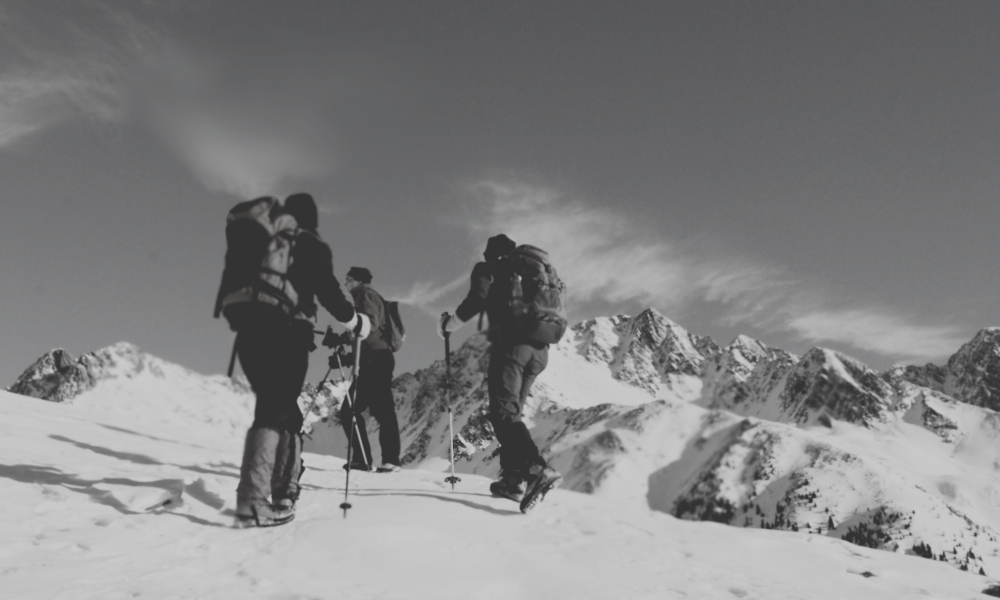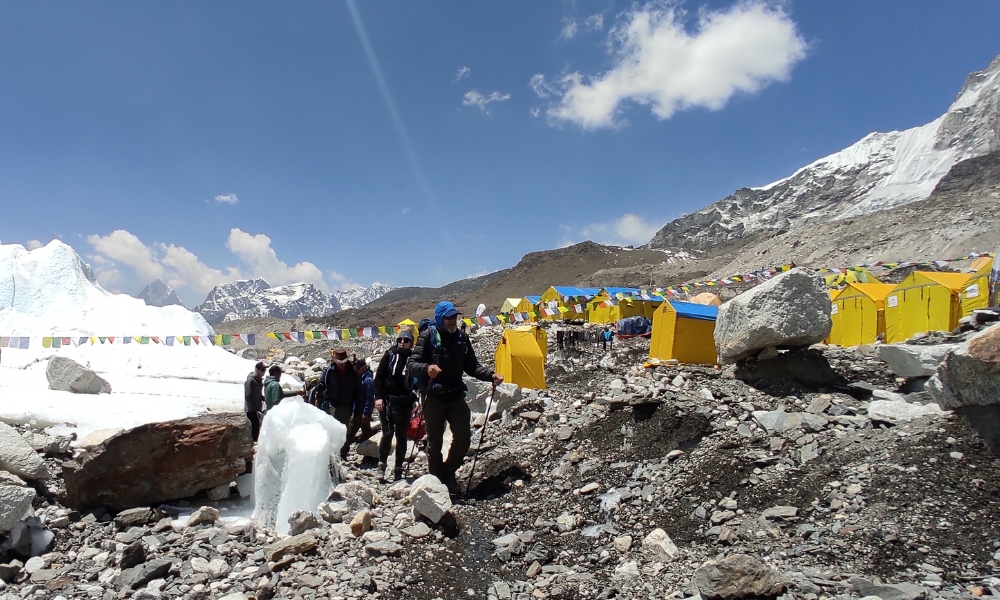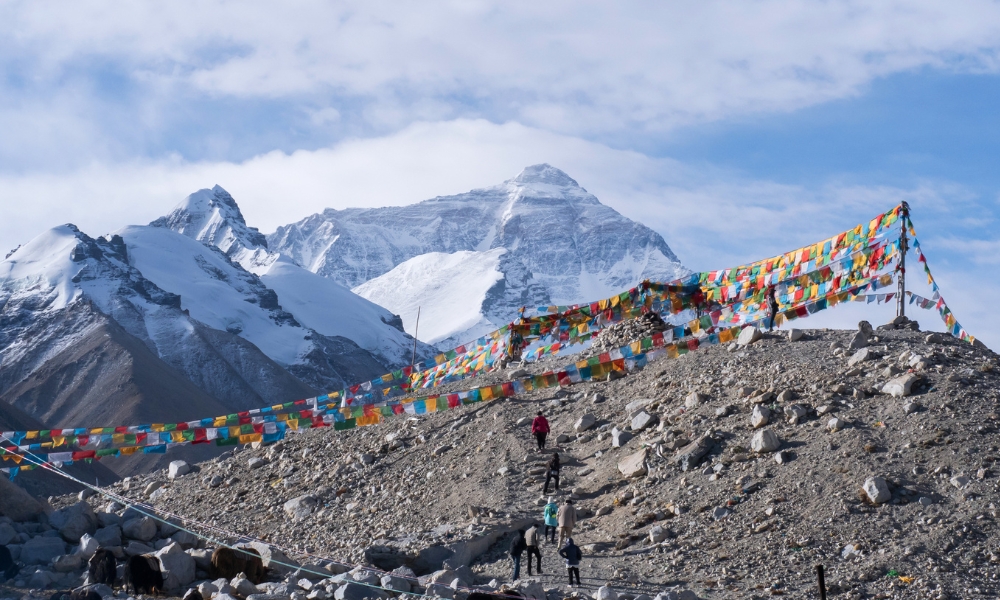Everest Base Camp (EBC) is the iconic starting point for expeditions attempting to summit Mount Everest's highest mountain. Positioned on two sides of the mountain, the base camps serve as vital preparation zones for climbers before they attempt the arduous ascent to Everest's 8,848.86 meters (29,031.7 ft) summit. The South Base Camp is located in Nepal at an altitude of 5,364 meters (17,598 ft), while the North Base Camp is situated in Tibet (China) at 5,150 meters (16,900 ft). Both camps are crucial staging points for climbers, providing logistical support and a safe place for acclimatization before advancing to higher camps.
History of Everest Base Camps & Locations
The history of Everest Base Camps is intrinsically tied to the early efforts to climb Mount Everest. In 1921, the first reconnaissance expedition led by George Mallory and other British climbers established the North Base Camp in Tibet. This location remained the primary base camp until political tensions in Tibet closed access to foreign climbers in the mid-20th century. This prompted the exploration of alternative routes from the south in Nepal.
Nepal opened its borders to mountaineers in the early 1950s, and the South Base Camp became the focus of expeditions. The 1953 British expedition, led by Colonel John Hunt, established the South Base Camp as their starting point. This expedition ultimately saw the first successful summit of Mount Everest by Sir Edmund Hillary and Tenzing Norgay Sherpa, cementing the South Base Camp as the main route to the summit.

Early Attempts and Ascents from the Base Camps
Both North and South Base Camps witnessed numerous failed attempts before climbers succeeded in reaching Everest's peak. The North Base Camp in Tibet saw the earliest significant attempts, notably George Mallory’s and Andrew Irvine's fateful climb in 1924, where both climbers disappeared near the summit, sparking debates on whether they had reached the top before their deaths.
The North Base Camp also witnessed the failed 1933 British expedition, where climbers were thwarted by poor weather conditions and altitude sickness. With Tibet's borders closed attention shifted to the South Base Camp in Nepal, where several expeditions encountered similar failures due to unpredictable weather, avalanches, and altitude challenges.
It wasn't until 1953 that the South Base Camp became legendary with the successful ascent of Sir Edmund Hillary and Tenzing Norgay. This triumph, facilitated by advanced climbing techniques, better acclimatization strategies, and superior logistics, opened the floodgates for future expeditions.
The Role of Everest Base Camps in Successful Summit
Base camps serve as more than just starting points for Everest expeditions; they are crucial acclimatization hubs that allow climbers to adjust to high altitudes gradually. Both camps provide essential support infrastructure, including tents, medical facilities, communication systems, and supplies. Climbers typically spend several weeks moving up and down between higher camps and base camps to condition their bodies for the reduced oxygen levels encountered at higher altitudes.
The South Base Camp, in particular, has evolved to become a small, temporary village during climbing seasons, accommodating hundreds of climbers, Sherpas, and support staff. From here, mountaineers ascend through the treacherous Khumbu Icefall to reach higher camps, eventually reaching the summit via the Southeast Ridge route.
The North Base Camp, while less frequented, offers a more straightforward route to the summit via the North Ridge. This route, however, is technically more challenging due to higher exposure to winds and less logistical support. In both cases, base camps are essential for monitoring weather patterns, managing logistics, and ensuring climbers are equipped for the perilous journey ahead.
South Everest Base Camp (Nepal)
The South Base Camp is the one everyone’s talking about when they say, “I’m trekking to Everest Base Camp.” Sitting at 5,364 meters (17,598 ft), it’s part of the famous Khumbu region in Nepal and is surrounded by breathtaking peaks like Ama Dablam, Lhotse, and Nuptse.
This is the heart of the Everest trekking scene. Every year, thousands of adventurers start their journey here, not just to conquer the mountain, but to enjoy the journey through Sherpa villages, high-altitude passes, and awe-inspiring landscapes.

How to Get to South Everest Base Camp
The trip begins with a thrilling flight from Kathmandu to Lukla, known for having one of the world’s most dramatic airstrips. From Lukla, it’s a 12-14 day trek that winds through the charming village of Namche Bazaar (your gateway to Sherpa culture), then on to the serene Tengboche Monastery, and finally up to Everest Base Camp itself.
This route is famous for both its beauty and the acclimatization-friendly itinerary, making it the top choice for trekkers who want a real challenge without technical climbing.
To trek in the Khumbu region, you’ll need two permits. First, the Sagarmatha National Park Entry Permit (easily available in Kathmandu or Monjo). Second, you’ll need the Khumbu Pasang Lhamu Rural Municipality Permit, which you can get in Lukla. Both are simple to arrange and can be organized by your trekking agency.
North Everest Base Camp (Tibet)
North Everest Base Camp in Tibet offers a completely different experience. Located at 5,150 meters (16,900 ft), it’s less crowded and more remote. While the South Base Camp is all about trekking and adventure, the North Base Camp offers jaw-dropping views of Everest’s majestic North Face—you’ll be much closer to the mountain here.
The Tibetan side is more about the journey than the trek itself. You can drive most of the way to base camp, making it ideal for those who want the Everest experience without weeks of trekking.

How to Get to North Everest Base Camp
The adventure to tour North Base Camp starts in Lhasa, Tibet’s capital. From there, you’ll embark on a stunning road trip across the Tibetan Plateau, passing through the historic towns of Shigatse and Shegar, until you reach the Everest Nature Reserve. The drive alone is worth the trip, with its wide-open landscapes and striking Tibetan monasteries.
Because Tibet has stricter regulations, you’ll need to join a guided tour, and foreigners can’t visit independently. But don’t let that deter you—it’s one of the most unique ways to experience Everest. You can take advantage of the opportunity to see more places in a single trip by seeing Lhasa and Mount Kailash while at Everest Base Camp in Tibet.
For Tibet, you need a bit more paperwork. A Tibet Travel Permit is required to enter the region, and this is only issued through a licensed travel agency. You’ll also need a Mount Everest Nature Reserve Permit, and of course, a Chinese Visa to get into Tibet in the first place. The good news is that your tour operator usually handles all this for you.
Ready to Trek? Book Your Everest Adventure Today!
Whether you’re drawn to the bustling trails of the South Base Camp trek in Nepal or want to explore the rugged beauty of Tibet’s North Base Camp, we’ve got you covered. Our expert guides will lead you through the journey of a lifetime, ensuring you’re well-prepared for every step of the way.
Book Your Everest Base Camp Trek with our exclusive packages! With tailored itineraries, all necessary permits, and top-notch accommodations, we make your dream of experiencing Everest a reality.
How South Everest Base Camp Became a Trekker’s Attraction
Everest Base Camp was initially exclusive to mountaineers attempting to conquer Everest. However, by the late 20th century, the allure of experiencing the world’s highest mountain up close sparked a new trend in adventure trekking. As Nepal’s tourism industry grew, particularly after the 1990s, the trek to South Base Camp became a popular challenge for non-climbers seeking to experience Everest without attempting the summit.
The trek to Everest Base Camp starts from the small town of Lukla, passing through the heart of the Solu-Khumbu region, home to the Sherpa people. Along the way, trekkers encounter breathtaking landscapes, Sherpa culture, and several iconic spots like Namche Bazaar, Tengboche Monastery, and the Sagarmatha National Park. Reaching the base camp itself has become a bucket-list item for adventurers worldwide.
By the early 2000s, trekking companies began offering guided trips to Everest Base Camp, turning it into a mainstream adventure destination. This increased accessibility led to a sharp rise in the number of trekkers visiting the region, with thousands of trekkers completing the trek each year.
Changes in Everest Base Camp Over Time
The growing popularity of the Everest Base Camp trek has led to significant changes in the area, both positive and negative. On the positive side, increased tourism has brought economic benefits to local communities. The demand for better infrastructure has led to improved trails, the establishment of teahouses, and communication facilities along the trekking route. Sherpas, renowned for their mountaineering expertise, have also seen increased employment opportunities as guides and porters.
However, this influx of tourists has also resulted in environmental challenges. Everest Base Camp, particularly the South Base Camp, has struggled with waste management issues. The increase in trekkers and expeditions has contributed to accumulating non-biodegradable waste, including discarded tents, oxygen bottles, and other climbing gear. The sheer number of visitors has put a strain on the fragile ecosystem, leading to erosion, deforestation, and pollution in the Khumbu region.
Is Everest Base Camp in Threat?
The Everest Base Camp, while a popular destination, faces several dangers that threaten its future. One of the most pressing concerns is the environmental degradation caused by human activity. As previously mentioned, the accumulation of waste has become a significant issue. Although cleanup efforts have been initiated in recent years, including government-backed initiatives like the Everest Cleanup Campaign, the sheer volume of waste continues to pose a threat to the pristine environment.
Another challenge is the impact of climate change. The glaciers surrounding Everest, including the Khumbu Glacier near the South Base Camp, are melting at an alarming rate due to global warming. This not only alters the landscape but also increases the risk of avalanches, crevasses, and glacier collapses, making both trekking and climbing more dangerous.
In addition, overcrowding has become a growing concern. Both climbers and trekkers now visit the base camp in large numbers, particularly during peak seasons. This has led to congestion on the trails and at the camp itself, reducing the overall experience and contributing to further environmental stress.
What Trekkers Can Do to Keep Everest Base Camp Safe
The future of Everest Base Camp depends on responsible trekking and climbing practices. Trekkers can play a vital role in preserving this iconic site by following some basic guidelines:
- Leave No Trace: One of the fundamental principles of trekking in fragile environments is to leave no trace. Trekkers should ensure they carry out all their waste, including plastic, paper, and organic waste, and avoid leaving any litter on the trails or at the base camp.
- Support Sustainable Tourism: Choosing eco-friendly trekking agencies and lodges that adhere to sustainable practices can help reduce the environmental impact of trekking. Many companies now focus on minimizing their carbon footprint and supporting local conservation efforts.
- Limit Group Sizes: Smaller trekking groups are less impactful on the environment and help prevent overcrowding on the trails. Reducing the number of trekkers visiting the base camp at one time can alleviate the strain on the local ecosystem.
- Respect Local Culture and Traditions: The Khumbu region is home to the Sherpa people, and respecting their culture and traditions is essential. Supporting local businesses and contributing to community-based tourism initiatives can ensure that the benefits of trekking are shared with the local population.
- Participate in Cleanup Efforts: Trekkers can join or support cleanup initiatives in the Everest region. Several organizations are actively involved in cleaning up Everest and its surrounding areas, and trekkers can contribute either by volunteering or donating to these causes.
Conclusion
Everest Base Camp is not only a vital location for mountaineers attempting to summit the world's highest peak but also a cultural and natural treasure for trekkers. Its rich history, from early expeditions to the development of a thriving trekking industry, has made it a symbol of adventure and human determination. However, the increasing popularity of Everest Base Camp has brought with it environmental challenges that threaten its future. By promoting responsible trekking and mountaineering practices, the next generation of adventurers can ensure that Everest Base Camp remains a cherished destination for years to come.


